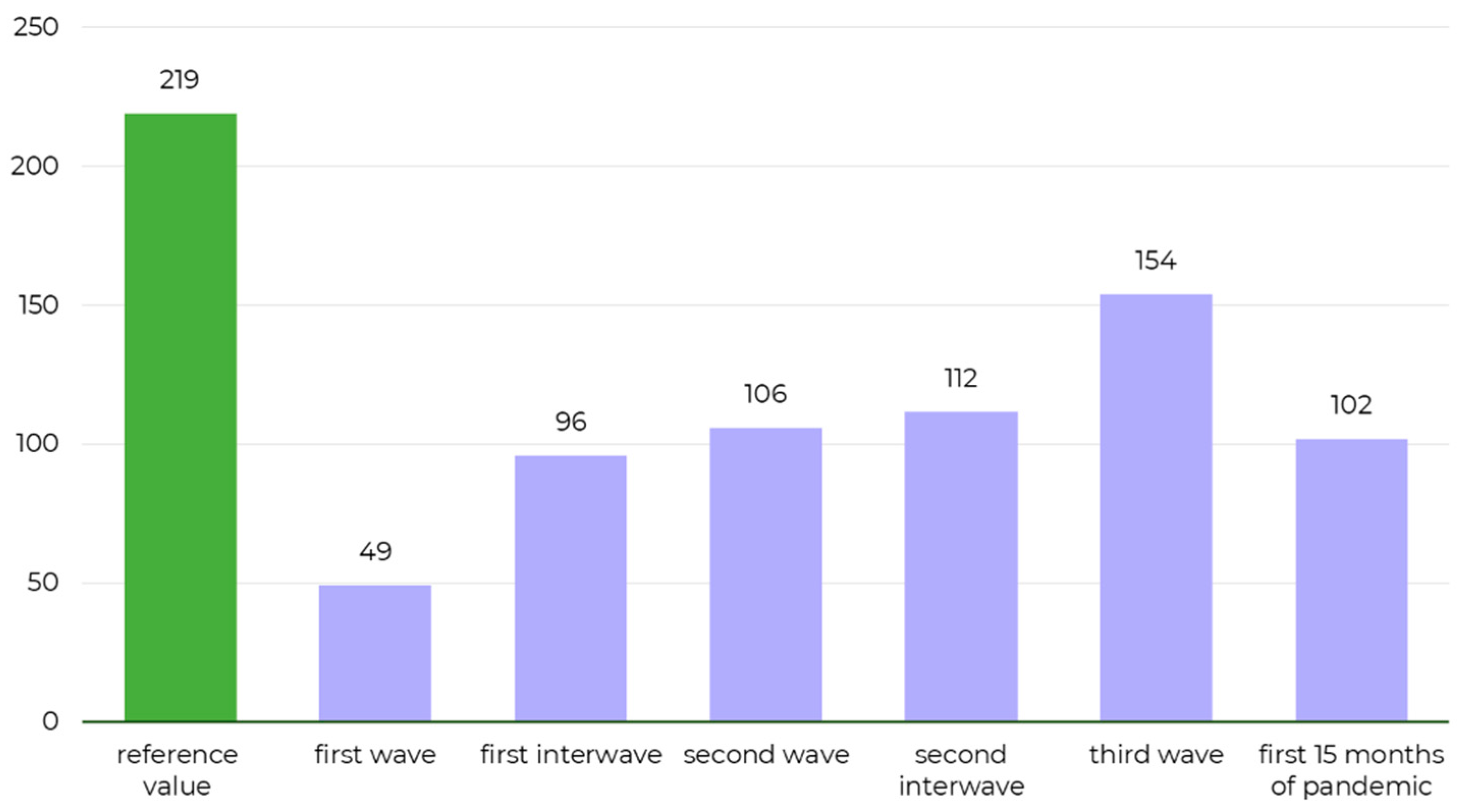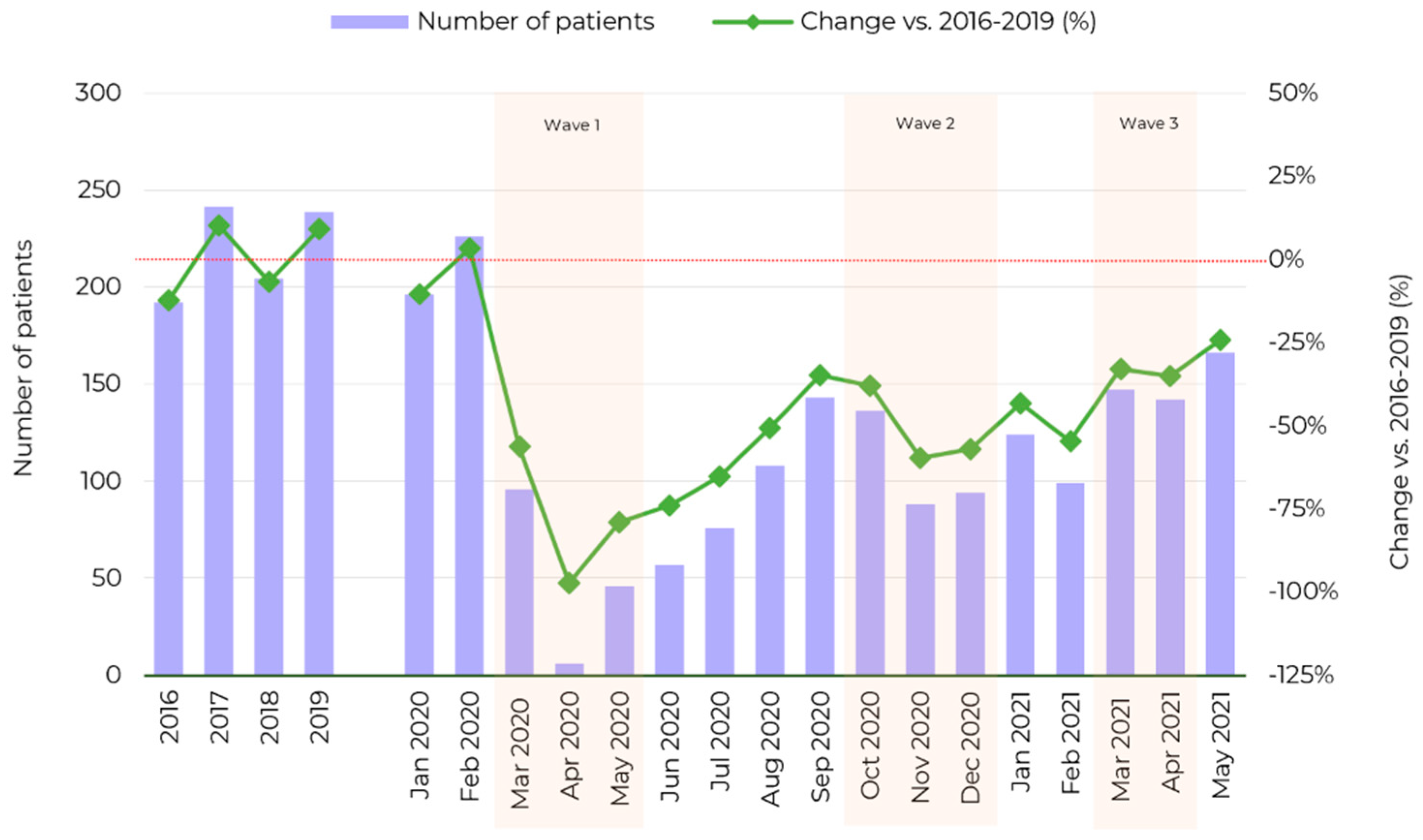Impact of Three Waves of the COVID-19 Pandemic on the Rate of Elective Cataract Surgeries at a Tertiary Referral Center: A Polish Perspective
Abstract
:1. Introduction
2. Materials and Methods
2.1. Study Design, Participants, Eligibility Criteria and Ethics
2.2. Procedure/Proceedings
2.3. Statistical Analysis
3. Results
3.1. The Impact of the COVID-19 Pandemic on the Number of Elective Cataract Surgeries during the First 15 Months after the Outbreak
3.2. The Impact of Three Waves of the COVID-19 Pandemic on the Number of Elective Cataract Surgeries
4. Discussion
5. Conclusions
Supplementary Materials
Author Contributions
Funding
Institutional Review Board Statement
Informed Consent Statement
Data Availability Statement
Conflicts of Interest
References
- Kam, A.W.; Gunasekaran, N.; Chaudhry, S.G.; Vukasovic, M.; White, A.J.; Fung, A.T. Reduction in Ophthalmic Presentations to Australian Emergency Departments During the COVID-19 Period: Are We Seeing the Full Picture? Clin. Ophthalmol. 2021, 15, 341–346. [Google Scholar] [CrossRef]
- Toro, M.D.; Brézin, A.P.; Burdon, M.; Cummings, A.B.; Kemer, O.E.; Malyugin, B.E. Early impact of COVID-19 outbreak on eye care: Insights from EUROCOVCAT group. Eur. J. Ophthalmol. 2021, 31, 5–9. [Google Scholar] [CrossRef]
- Al-Khersan, H.; Kalavar, M.A.; Tanenbaum, R.; Lazzarini, T.A.; Patel, N.A.; Yannuzzi, N.A. Emergent Ophthalmic Surgical Care at a Tertiary Referral Center During the COVID-19 Pandemic. Am. J. Ophthalmol. 2021, 222, 368–372. [Google Scholar] [CrossRef]
- Wickham, L.; Hay, G.; Hamilton, R.; Wooding, J.; Tossounis, H.; Da Cruz, L. The impact of COVID policies on acute ophthalmology services—Experiences from Moorfields Eye Hospital NHS Foundation Trust. Eye 2020, 34, 1189–1192. [Google Scholar] [CrossRef]
- Tognetto, D.; Brézin, A.P.; Cummings, A.B.; Malyugin, B.E.; Kemer, O.E.; Prieto, I. Rethinking Elective Cataract Surgery Diagnostics, Assessments, and Tools after the COVID-19 Pandemic Experience and Beyond: Insights from the EUROCOVCAT Group. Diagnostics 2020, 10, 1035. [Google Scholar] [CrossRef]
- Li, J.-P.O.; Liu, H.; Ting, D.S.; Jeon, S.; Chan, R.P.; Kim, J.E. Digital technology, tele-medicine and artificial intelligence in ophthalmology: A global perspective. Prog. Retin. Eye Res. 2021, 82, 100900. [Google Scholar] [CrossRef]
- Sii, S.S.Z.; Chean, C.S.; Sandland-Taylor, L.E.; Anuforom, U.; Patel, D.; Le, G.T.; Khan, A.J. Impact of COVID-19 on cataract surgery- patients’ perceptions while waiting for cataract surgery and their willingness to attend hospital for cataract surgery during the easing of lockdown period. Eye 2020, 1–3. [Google Scholar] [CrossRef]
- Lin, P.-F.; Naveed, H.; Eleftheriadou, M.; Purbrick, R.; Ghanavati, M.Z.; Liu, C. Cataract service redesign in the post-COVID-19 era. Br. J. Ophthalmol. 2021, 105, 745–750. [Google Scholar] [CrossRef]
- Cheng, K.K.; Anderson, M.J.; Velissaris, S.; Moreton, R.; Al-Mansour, A.; Sanders, R. Cataract risk stratification and prioritisation protocol in the COVID-19 era. BMC Heal. Serv. Res. 2021, 21, 153. [Google Scholar] [CrossRef]
- Vieira, R.; Baptista, P.; Castro, C.; Leite, J.; Menéres, M.J.; Menéres, P. Return of phacoemulsification after emergency status related to COVID-19: Experience of a tertiary referral center. J. Cataract. Refract. Surg. 2021, 47, 691–694. [Google Scholar] [CrossRef]
- Reddy, J.; Vaddavalli, P.; Sharma, N.; Sachdev, M.; Rajashekar, Y.; Sinha, R. A new normal with cataract surgery during COVID-19 pandemic. Indian J. Ophthalmol. 2020, 68, 1269–1276. [Google Scholar] [CrossRef]
- Reddy, J.C.; Vaddavalli, P.K. Serving patients in the COVID-19 pandemic. Community Eye Health 2020, 33, 39. [Google Scholar]
- Ahmed, I.I.K.; Hill, W.E.; Arshinoff, S.A. Bilateral Same-Day Cataract Surgery: An Idea Whose Time Has Come #COVID-19. Ophthalmology 2021, 128, 13–14. [Google Scholar] [CrossRef]
- Kohnen, T. The new normal for cataract and refractive surgery due to COVID-19 (SARS-CoV-2). J. Cataract. Refract. Surg. 2020, 46, 809–810. [Google Scholar] [CrossRef] [PubMed]
- Immediate Sequential Bilateral Cataract Surgery (ISBCS) during COVID Recovery: RCOphth/UKISCRS Rapid Advice Document. 2020. Available online: https://www.rcophth.ac.uk/wp-content/uploads/2020/07/Immediate-Sequetial-Bilateral-Cataract-Surgery-Guidance-2.pdf (accessed on 3 June 2021).
- Naderi, K.; Maubon, L.; Jameel, A.; Patel, D.S.; Gormley, J.; Shah, V. Attitudes to cataract surgery during the COVID-19 pandemic: A patient survey. Eye 2020, 34, 2161–2162. [Google Scholar] [CrossRef]
- Dong, E.; Du, H.; Gardner, L. An interactive web-based dashboard to track COVID-19 in real time. Lancet Infect. Dis. 2020, 20, 533–534. [Google Scholar] [CrossRef]
- Guide to NHS waiting times in England-NHS. Available online: https://www.nhs.uk/nhs-services/hospitals/guide-to-nhs-waiting-times-in-england/ (accessed on 4 August 2021).
- Długosz, P. Predictors of Mental Health after the First Wave of the COVID-19 Pandemic in Poland. Brain Sci. 2021, 11, 544. [Google Scholar] [CrossRef]
- Agrawal, R.; Gupta, P.; Tan, K.-A.; Cheung, C.M.G.; Wong, T.-Y.; Cheng, C.-Y. Choroidal vascularity index as a measure of vascular status of the choroid: Measurements in healthy eyes from a population-based study. Sci. Rep. 2016, 6, 21090. [Google Scholar] [CrossRef]
- Docherty, A.B.; Harrison, E.M.; Green, C.A.; Hardwick, H.E.; Pius, R.; Norman, L.; Holden, K.A. Features of 20 133 UK patients in hospital with covid-19 using the ISARIC WHO Clinical Characterisation Protocol: Prospective observational cohort study. BMJ 2020, 369, m1985. [Google Scholar] [CrossRef]
- Konopińska, J.; Obuchowska, I.; Lisowski, Ł.; Dub, N.; Kozera, M.; Rękas, M. Intention to Get COVID-19 Vaccinations among Ophthalmology Residents in Poland: A Cross-Sectional Survey. Vaccines 2021, 9, 371. [Google Scholar] [CrossRef]
- Mathieu, E.; Ritchie, H.; Ortiz-Ospina, E.; Roser, M.; Hasell, J.; Appel, C. A global database of COVID-19 vaccinations. Nat. Hum. Behav. 2021, 5, 947–953. [Google Scholar] [CrossRef]
- Fong, C.S.-U.; Mitchell, P.; Rochtchina, E.; Teber, E.T.; Hong, T.; Wang, J.J. Correction of Visual Impairment by Cataract Surgery and Improved Survival in Older Persons: The Blue Mountains Eye Study cohort. Ophthalmology 2013, 120, 1720–1727. [Google Scholar] [CrossRef] [PubMed]
- Wang, J.J.; Mitchell, P.; Simpson, J.M.; Cumming, R.G.; Smith, W. Visual impairment, age-related cataract, and mortality. Arch. Ophthalmol. 2001, 119, 1186–1190. [Google Scholar] [CrossRef]
- Ishii, K.; Kabata, T.; Oshika, T. The Impact of Cataract Surgery on Cognitive Impairment and Depressive Mental Status in Elderly Patients. Am. J. Ophthalmol. 2008, 146, 404–409. [Google Scholar] [CrossRef] [PubMed]
- Choi, H.G.; Lee, J.K.; Lee, M.J.; Park, B.; Sim, S.; Lee, S.-M. Blindness increases the risk for hip fracture and vertebral fracture but not the risk for distal radius fracture: A longitudinal follow-up study using a national sample cohort. Osteoporos. Int. 2020, 31, 2345–2354. [Google Scholar] [CrossRef] [PubMed]
- Yu, W.-K.; Chen, Y.-T.; Wang, S.-J.; Kuo, S.-C.; Shia, B.-C.; Liu, C.J.-L. Cataract surgery is associated with a reduced risk of dementia: A nationwide population-based cohort study. Eur. J. Neurol. 2014, 22, 1370-e80. [Google Scholar] [CrossRef] [PubMed]
- Rush, S.W.; Gerald, A.E.; Smith, J.C.; Rush, A.J.; Rush, R.B. Prospective analysis of outcomes and economic factors of same-day bilateral cataract surgery in the United States. J. Cataract. Refract. Surg. 2015, 41, 732–739. [Google Scholar] [CrossRef]
- Leivo, T.; Sarikkola, A.-U.; Uusitalo, R.J.; Hellstedt, T.; Ess, S.-L.; Kivelä, T. Simultaneous bilateral cataract surgery: Economic analysis; Helsinki Simultaneous Bilateral Cataract Surgery Study Report 2. J. Cataract. Refract. Surg. 2011, 37, 1003–1008. [Google Scholar] [CrossRef] [PubMed]
- Hussain, R.; Singh, B.; Shah, N.; Jain, S. Impact of COVID-19 on ophthalmic specialist training in the United Kingdom—the trainees’ perspective. Eye 2020, 34, 2157–2160. [Google Scholar] [CrossRef] [PubMed]
- Szigiato, A.-A.; Palakkamanil, M.; Aubin, M.-J.; Ziai, S. Canadian ophthalmology resident experience during the COVID-19 pandemic. Can. J. Ophthalmol. 2021, 56, e42–e44. [Google Scholar] [CrossRef]


Publisher’s Note: MDPI stays neutral with regard to jurisdictional claims in published maps and institutional affiliations. |
© 2021 by the authors. Licensee MDPI, Basel, Switzerland. This article is an open access article distributed under the terms and conditions of the Creative Commons Attribution (CC BY) license (https://creativecommons.org/licenses/by/4.0/).
Share and Cite
Dmuchowska, D.A.; Pieklarz, B.; Konopinska, J.; Mariak, Z.; Obuchowska, I. Impact of Three Waves of the COVID-19 Pandemic on the Rate of Elective Cataract Surgeries at a Tertiary Referral Center: A Polish Perspective. Int. J. Environ. Res. Public Health 2021, 18, 8608. https://doi.org/10.3390/ijerph18168608
Dmuchowska DA, Pieklarz B, Konopinska J, Mariak Z, Obuchowska I. Impact of Three Waves of the COVID-19 Pandemic on the Rate of Elective Cataract Surgeries at a Tertiary Referral Center: A Polish Perspective. International Journal of Environmental Research and Public Health. 2021; 18(16):8608. https://doi.org/10.3390/ijerph18168608
Chicago/Turabian StyleDmuchowska, Diana Anna, Barbara Pieklarz, Joanna Konopinska, Zofia Mariak, and Iwona Obuchowska. 2021. "Impact of Three Waves of the COVID-19 Pandemic on the Rate of Elective Cataract Surgeries at a Tertiary Referral Center: A Polish Perspective" International Journal of Environmental Research and Public Health 18, no. 16: 8608. https://doi.org/10.3390/ijerph18168608
APA StyleDmuchowska, D. A., Pieklarz, B., Konopinska, J., Mariak, Z., & Obuchowska, I. (2021). Impact of Three Waves of the COVID-19 Pandemic on the Rate of Elective Cataract Surgeries at a Tertiary Referral Center: A Polish Perspective. International Journal of Environmental Research and Public Health, 18(16), 8608. https://doi.org/10.3390/ijerph18168608






